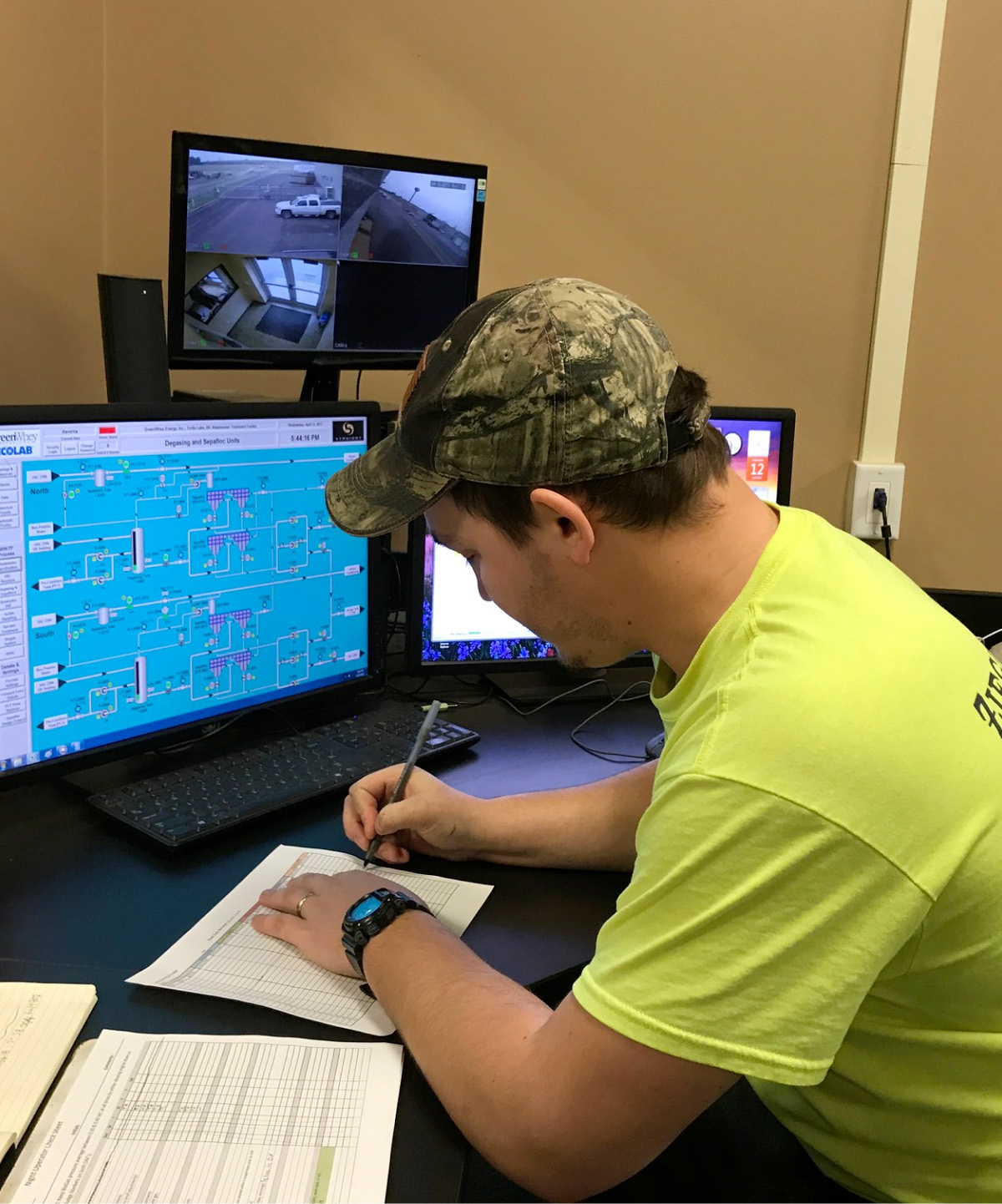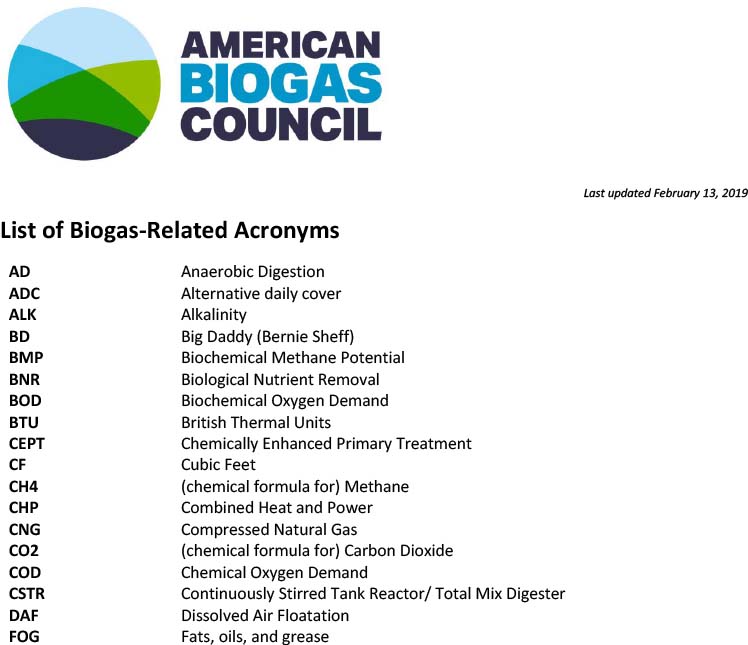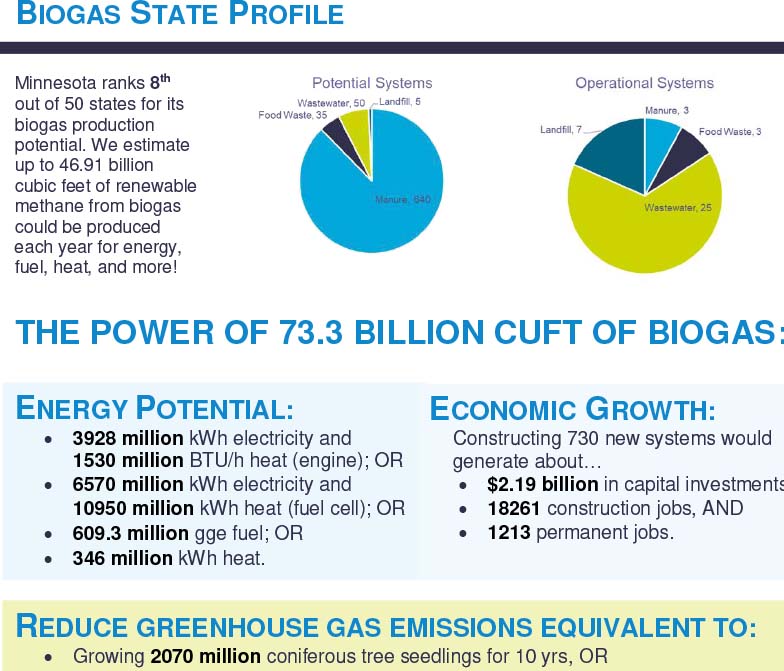Harness the Benefits of Biogas
Learn how biogas systems can benefit you, your business, and your community.
Biogas systems recycle decomposable waste– like manure, food waste, wastewater solids and other organic material–into energy and fertilizer.
In the U.S., there is an urgent need to manage millions of tons of food, water and animal waste. The main benefits of biogas systems come from the fact that they are recycling all this material while also producing renewable energy and soil fertilizers.
Each year the United States produces:
- Over 120 million tons* of farm animal manure
- 12 million tons* of municipal wastewater biosolids (sludge)
- and sends more than 24,000,000 tons of inedible food waste to landfills.
In addition, at least 470 landfills currently flare gas that could be repurposed.
The ABC estimates that about 17,000 additional biogas projects could be built to:
- convert waste into valuable domestically-produced energy
- improve crop yields and nutrients
- preserve landfill space and
- create good-paying jobs

Energy Benefits
- A renewable source of energy that is a direct replacement for non-renewable, carbon-intensive fossil fuels
- Produce renewable energy 24/7/365 with a reliability rate of 95%–in comparison, the average reliability rate for solar power is 25% and 35% for wind power
- Biogas supports distributed generation of energy, which means lower transmission and transportation costs as well as reduced impact and higher reliability of electrical grids
- Systems with gas storage can provide renewable electricity on demand in minutes, reducing the need to turn on fossil fueled power plants to meet peak demand
- Renewable Natural Gas (RNG) procured from biogas can be used interchangeably with natural gas for heating, electricity, and the production of quality biomethane and transportation fuel
- By purchasing RNG, large gas customers support their ESG goals, reduce fossil fuel use, and decrease their carbon footprint
- The thermal heat needed in industrial manufacturing (that only gas can support) is responsible for around 11% of U.S. emissions. Biogas is currently the most sustainable way to address these emissions.
Economic Benefits
- A cost-effective solution to turning a high-cost deliverable like waste treatment into a revenue-generating opportunity for farmers and rural communities
- For companies that want to reduce their carbon footprint, some biogas systems are so carbon negative that replacing a small percentage of fossil gas with renewable biogas or renewable natural gas can help reach net-zero goals
- Create new revenue streams in rural America, building resiliency against commodity price fluctuations.
- Can reduce farm costs for animal bedding and fertilizer and generate new revenue streams.
- A driver for economic growth and offer local jobs in construction, engineering, project management and more
Reduce the volume of waste, meaning that costs are often lowered for facilities like wastewater plants


Environmental Benefits
- Recycle manure and kill odors and pathogens while producing renewable energy and soil products
- Help assist the natural cycles of recycling to farming
- Moving manure from open lagoons to an airtight biogas system reduces GHG emissions
- Reduce carbon emissions in transportation by at least half compared to fossil fuels
- Recycling manure creates an opportunity to separate nutrients and keep them out of waterways
- The use of digestate can replace costly synthetic fertilizers and can increase plant growth by 10-30 percent compared to synthetic fertilizers
- Plants absorb soil nutrients, like nitrogen or phosphorus, more easily than raw manure. This allows farmers to use the right volume and ratio of nutrients needed and minimize the additional purchase of synthetic fertilizers.
Biogas Industry Statistics

Today, the U.S. has close to 2,500 sites producing biogas in 50 states, including more than 600 farms, 1,189 water resource recovery facilities, 113 stand-alone systems that digest food waste and 583 landfills.

The U.S. currently has the potential to build 17,000 new biogas systems, which would create significant economic, environmental and energy benefits.

Building out the U.S. biogas infrastructure could produce an additional 204 billion kilowatt-hours of electricity per year (19 million homes), 185 billion BTU of renewable heat per hour (21 million homes), or fuel for vehicles equivalent to 13.5 billion gallons per year (31 million vehicles).

Building out the U.S. biogas infrastructure could generate at least $450 billion in new capital deployment for construction activity resulting in 900,000 short-term construction jobs and 45,000 permanent jobs.
How Biogas Systems Work
Select each step below to learn how biogas systems work
Step 1
1 ORGANIC MATERIAL
Organic materials are the “input” or “feedstock” for a biogas system. Some organic materials will digest more readily than others.
- Animal Manure
- Food Scraps
- Wastewater Biosolids
- Restaurant Grease
- Organic Byproducts
Step 2
2THE DIGESTER
An anaerobic digester is a system of airtight tanks that can be equipped for mixing and warming organic material.
Step 3a
3aBIOGAS
Biogas consists mostly of methane and carbon dioxide, plus water vapor, and other trace compounds (e.g., siloxanes)
- Heat
- Bioplastics
- Electricity
- Vehicle Fuel
- Renewable Natural Gas
Some biogas can be used to heat the digester!
Step 3b
3bDIGESTED MATERIAL (DIGESTATE)
In addition to biogas, digesters produce solid and liquid digestate, containing valuable nutrients (nitrogen, phosphorus & potassium) and organic carbon.
- Fertilizer
- Soil Amendments
- Animal Bedding
- Other Products
- Horticulture Products
Digested material may be returned for livestock, agricultural and gardening uses!
RNG
RENEWABLE NATURAL GAS
Biogas processed to gas pipeline quality is often called biomethane, renewable natural gas, or RNG.
Additional Resources

Biogas Market Snapshot
This one-pager includes high level information on the current state of the biogas industry and potential of biogas in the United States.

Biogas Acronyms
A list of acronyms you may find throughout this website and other biogas resources with their definitions.

State Profiles
This one-pager includes high level information on the current state of the biogas industry and potential of biogas in the United States.

Biogas Definitions
A list of words you may find throughout this website and other biogas resources with their definitions.